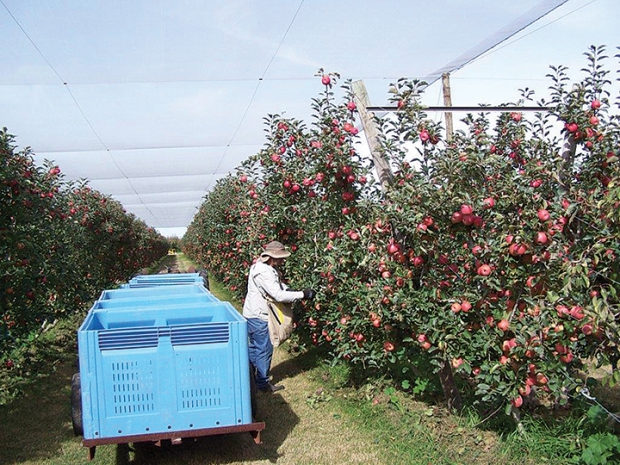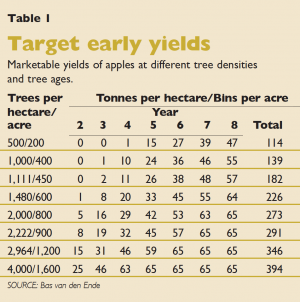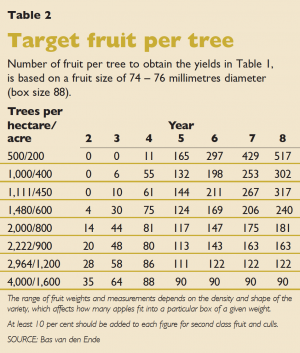
Hitting the target: This six-year-old, two-hectare (five-acre) Pink Lady block on Malling Merton 106 rootstocks, and trained on an open Tatura system, produced a gross yield of 236 tons per hectare (236 bins per acre) and a total marketable yield of 219 tons per hectare (219 bins per acre) from four harvests. Two-year-old feathered trees were planted on a 5.50- by 0.75-meter spacing for a tree density of 2,424 trees per hectare (981 trees per acre). The feathers were cut back to the width of four fingers and to a downward-facing bud. The trees were meticulously trained during the second and third summers with branches angled at 45 degrees. Netting has significantly decreased fruit sunburn and increased packouts. This netted orchard is located near Shepparton in the state of Victoria, Australia. (Courtesy Bas van den Ende)
Many factors contribute to the profitability of an orchard. The two most important factors are marketable yield per hectare and the price received for the fruit. Early yields also have a big impact on profitability of a new orchard. In the early years of an orchard, tree density generally has a greater effect on yield than does the training system. However, as the orchard matures, yields can differ depending on the tree training system used.
High yield per hectare, or per acre, requires a high percentage of light interception, whether in the first three years or when the orchard is fully bearing. The best way to obtain high early light interception and thus high early yields is to plant trees closely. The specific tree training used in the early years is less important than the tree density, as long as the spaces allotted to the trees are filled quickly with bearing wood. As the orchard matures, the training system must ensure that high light interception is achieved. The percentage of light intercepted by the orchard is the most important factor in determining yield. For optimum yields, the orchard should intercept at least 70 percent, but not more than 80 percent, of sunlight. All over the world, orchardists are embracing this concept to achieve early and high yields of marketable fruit.
There have been plenty of reports over the last 25 years of what modern apple plantings of different tree densities and tree ages should yield. The yields in Table 1 have been compiled from published reports and from some high-performing, closely planted orchards in Australia that can serve as benchmarks.
A ceiling yield of 65 tons per hectare, or 65 bins per acre, in year seven for apple orchards in Australia with more than 2,000 trees per hectare (800 trees per acre) is realistic and attainable, provided the trees are managed well. Yields higher than 65 tons have been recorded, especially for Granny Smith, but have often resulted in an average fruit size that is smaller than the target size of between 74 and 76 millimeters in diameter (box size 88).
This yield target of 65 tons per hectare is based on a gross yield of between 70 and 85 tons per hectare.
It is common for Australian orchardists to experience some level of sunburn on fruit, causing lower-value and more variable packouts. Losses due to sunburn can vary from 6 to 30 percent, depending on the season, the training system, and the variety. It is now common to see netting installed primarily for sun and hail protection.
Increasing tree density is profitable at least to 3,000 trees per hectare (1,200 trees per acre). Profitability of higher tree densities will likely follow the law of diminishing returns and increasing risk in Australia.
The early yields in Table 1 are only attainable if two-year-old feathered trees of high quality are planted, and trees are pruned less and trained more during the first three years. Thereafter, the maximum permissible tree height must be maintained, the canopy must be kept open for good distribution of sunlight, and the fruiting wood must be regularly renewed.
To achieve the yields in Table 1, Table 2 shows how many apples each tree should produce. Table 2 gives the number of fruit per tree for each density and tree age when the average fruit size at harvest is 74 to 76 millimeters (box size 88). This ready reckoner is meant to take much of the guesswork out of fruit thinning.
Orchardists in Australia regard tree density, training system, and climate the most important factors affecting yield.
For compelling economic reasons, apple growers in Australia are investing in high-density orchard systems, which are productive and produce fruit more efficiently than the old low-density orchards. The high investment dictates that production targets are set and met. Such production targets for Australian apple orchards of different tree densities and ages of trees were not readily available previously.
A search of literature on yield performance of high-density orchards and marketable yields of a number of well-managed apple plantings in Australia brought together target yields that orchardists can use with confidence for varieties such as Pink Lady, Sundowner, Granny Smith, Gala strains, Golden Delicious, Smoothee, Braeburn, and Jonagold. •
Van den Ende is a tree fruit consultant in Australia’s Goulburn Valley.








With more and more people wanting to homestead or at least have a back yard garden your production charts will be a big help.
Yes indeed! I agree with Karen Rivers! Thankyou so much for this very helpful article and the Target yield charts. My husband and I are Australians who have begun to manage an apple and apple seedling farm in Iringa District, near Ifunda, with an associated outgrower programme up in Njombe District, around Makete. Karibu any time Dr van den Ende!